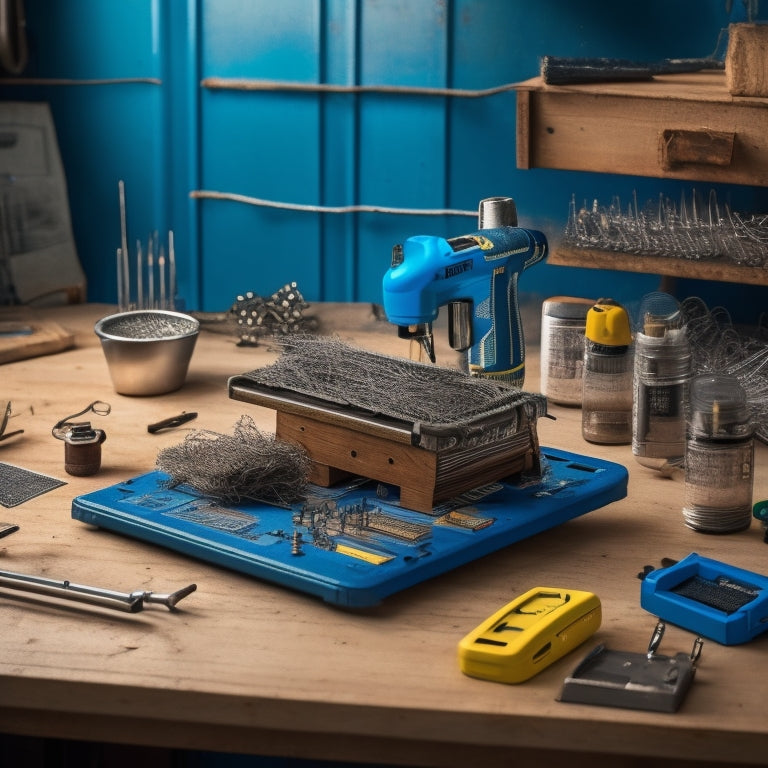
DIY Home Power Kits for Beginners
Share
When it comes to DIY home power kits for beginners, you'll want to prioritize efficiency, reliability, and compatibility. Start by choosing a solar kit with high-efficiency panels, a compatible battery bank, and a reliable charge controller to regulate energy flow. Consider key components like inverters, energy storage, and mounting hardware. As you set up your solar panel, optimize the angle, ascertain structural capacity, and secure mounting. With proper safety precautions and maintenance practices in place, you'll be well on your way to achieving energy independence. Now, take the next step and investigate the complexities of each component to guarantee a seamless and efficient off-grid energy system.
Key Takeaways
- Choose a solar kit with high-efficiency panels (above 20%), compatible energy storage, and a reliable solution for excess energy storage.
- Select deep-cycle batteries with sufficient capacity, considering factors like type, depth of discharge, and lifespan to ensure optimal performance.
- Ensure the charge controller regulates energy flow between the solar panel and battery, preventing damage and maintaining battery health.
- Inverters convert DC power from the battery to AC power for household use, so select the right type (string, microinverter, or power optimizer) based on system size and power needs.
- Regular maintenance practices, such as inspections, cleaning, and troubleshooting, are crucial to ensure the system's optimal performance and longevity.
Choosing the Right Solar Kit
When selecting a DIY home power kit, the solar panel kit is an essential component that warrants careful evaluation.
You'll want to choose a kit with high solar panel efficiency to maximize energy production. Look for panels with high-efficiency ratings, usually above 20%.
High-efficiency panels like monocrystalline and bifacial types can convert sunlight into electricity effectively. Additionally, reflect on the type of solar panel that suits your needs, such as polycrystalline or thin-film, each with its own advantages.
Energy storage is another vital aspect to reflect on. You'll need a compatible battery bank to store excess energy generated during the day for use during the night or on cloudy days.
Ascertain the battery bank is designed for deep-cycle use and has a sufficient capacity to meet your energy needs. A well-matched solar panel kit and energy storage system will provide a reliable and efficient DIY home power solution.
Key Components of Portable Systems
Your portable DIY home power kit relies on several key components to provide electricity on-the-go. A high-efficiency solar panel is essential, as it converts sunlight into electrical energy. Look for panels with high solar panel efficiency ratings to maximize energy output.
When selecting a solar panel, consider residential solar panel bundles that combine panels, inverters, and mounting hardware for convenience and typically come with warranties lasting at least 25 years. Additionally, think about energy storage needs and the potential for system expansion when planning.
A deep cycle battery stores excess energy generated by the solar panel, providing a reliable power source when the sun isn't shining. A charge controller regulates the flow of energy between the solar panel and battery, preventing overcharging or undercharging.
An inverter converts the DC power stored in the battery to AC power, making it suitable for your portable power options, such as laptops, lights, or small appliances. These components work together to provide a reliable and efficient portable power solution.
Setting Up Your Solar Panel
You'll need to optimize your solar panel's angle to maximize energy generation, as even a slight deviation from the ideal angle can result in significant energy losses.
To achieve this, you'll need to take into account your location's latitude and the time of year, adjusting the panel's angle accordingly.
Additionally, verify the roof can handle the weight of solar panels; understand structural capacity and conduct thorough structural inspections to identify weaknesses.
Make certain to securely fasten the mount to prevent damage or misalignment from wind or other environmental factors.
Panel Angle Matters
Most solar panels installed on residential rooftops operate at an average efficiency of around 15-20%.
To maximize your panel's energy output, you need to evaluate the panel angle. The ideal angle depends on your location and the time of year. In general, you want to tilt your panel at an angle equal to your latitude to optimize sunlight exposure. For example, if you live at 30° latitude, your panel should be tilted at 30°.
Adjusting the panel orientation seasonally can further enhance energy production. During winter, you can tilt the panel at a steeper angle to capture more sunlight, while a shallower angle is better for summer.
Secure the Mount
A sturdy mounting system is the backbone of a successful solar panel installation, providing a secure foundation for peak energy harvesting.
You'll want to choose a mounting system that suits your roof type and guarantees secure installations. Consider factors like wind resistance, weight capacity, and adjustability.
Research different mounting techniques, such as roof-ground or ballasted systems, to determine the best fit for your DIY project.
Make certain to follow the manufacturer's instructions for assembly and installation. A well-secured mount will prevent damage to your solar panel and roof, guaranteeing a safe and efficient energy-generating system.
Charge Controllers for Beginners
Tapping into the world of DIY home power kits requires a solid understanding of charge controllers, the unsung heroes of off-grid energy systems.
As you commence your solar expedition, you'll need a charge controller to regulate the solar charging process. This device guarantees your batteries are safely charged, preventing overcharging or undercharging.
You'll encounter two primary controller types: PWM (Pulse Width Modulation) and MPPT (Maximum Power Point Tracking). PWM controllers are cost-effective but less efficient, while MPPT controllers optimize energy harvest, albeit at a higher cost.
When selecting a charge controller, consider your system's voltage, current, and solar panel wattage to assure seamless integration.
Selecting Deep Cycle Batteries
You'll need to choose the right deep cycle battery type for your DIY home power kit, weighing options like flooded lead-acid, sealed AGM, or maintenance-free gel batteries.
When selecting a battery, you'll also need to take into account its depth of discharge (DOD), which affects its overall lifespan and performance.
A battery's DOD determines how much of its capacity can be safely used without damaging the battery.
Battery Type Options
Selecting the right battery type is crucial for a successful DIY home power kit. You'll need to evaluate factors like battery lifespan, maintenance, and safety when choosing the best option for your system. Lithium batteries offer high energy density and long lifetimes, but are generally more expensive. Gel batteries and AGM (Absorbed Glass Mat) batteries are both types of lead acid batteries, with gel batteries being more maintenance-free and AGM batteries providing better performance.
| Battery Type | Advantages | Disadvantages |
|---|---|---|
| Lithium | High energy density, long lifespan | Expensive, sensitive to temperature |
| Gel | Maintenance-free, long lifespan | Lower energy density, slower discharge rates |
| AGM | Good performance, low maintenance | Lower energy density, heavier than lithium |
When selecting a battery, evaluate your system's solar compatibility, battery sizing, and discharge rates to guarantee peak performance.
Depth of Discharge
When configuring your DIY home power kit, understanding the depth of discharge (DOD) is crucial for ideal battery performance and longevity.
DOD refers to the percentage of a battery's capacity that's used before recharging. You want to choose deep cycle batteries with a suitable DOD rating for your system. A higher DOD means more energy is withdrawn from the battery, reducing its lifespan.
Aim for a DOD between 20% and 50% for best performance. Avoid deep discharging, as it can reduce the battery's lifespan and number of discharge cycles.
For example, if you have a 1000Ah battery with a 50% DOD, you can use 500Ah of energy before recharging.
Inverters for Off-Grid Power
Utilizing off-grid power requires an essential component: an inverter that efficiently converts DC power from your renewable energy source into usable AC power for your home. When it comes to solar power, you'll need an inverter that can handle the variable input from your solar panels. You have three main inverter types to choose from: string inverters, microinverters, and power optimizers.
| Inverter Type | Description | Benefits |
|---|---|---|
| String Inverter | Converts DC power from entire solar array | Cost-effective, easy to install |
| Microinverter | Converts DC power from individual solar panels | Maximum energy harvest, real-time monitoring |
| Power Optimizer | Optimizes DC power from individual panels, then converts to AC | Flexible installation, improved safety |
Each inverter type has its advantages, and the right choice depends on your specific solar power setup and needs.
Safety Precautions and Maintenance
With your solar power system up and running, it's now imperative to guarantee its safe and efficient operation through regular maintenance and adherence to safety precautions.
You must ascertain you're aware of potential electrical hazards, such as faulty wiring or overheating components, which can lead to fires. Regularly inspect your system for signs of wear or damage, and address any issues promptly.
Keep flammable materials away from the system, and guarantee proper ventilation to prevent overheating.
Additionally, follow proper fire safety protocols, such as having a fire extinguisher nearby and knowing your emergency escape routes.
Frequently Asked Questions
Can I Use DIY Solar Kits to Power My Entire Home?
Coincidentally, you're considering solar power just as electricity rates are skyrocketing! Yes, you can use DIY solar kits to power your entire home, leveraging solar energy benefits like cost savings, but first, assess your energy needs and local building codes.
Are DIY Solar Kits Compatible With Existing Electrical Systems?
You'll need to contemplate compatibility concerns and potential installation challenges when integrating a DIY solar kit with your existing electrical system, ensuring the kit's voltage and current outputs match your system's requirements to avoid safety hazards and efficiency losses.
Do I Need a Professional to Install a DIY Solar Kit?
You're tempted to go solo, but don't risk it; improper installation can lead to electrical shock or fires. Heed professional recommendations and prioritize installation safety - it's worth the extra cost to guarantee a secure and efficient setup.
Can I Mix and Match Components From Different DIY Solar Kits?
When mixing and matching components from different DIY solar kits, you'll need to ascertain component compatibility to maintain solar kit efficiency. Check voltage, current, and connector types to verify seamless integration and peak performance.
Are DIY Solar Kits Eligible for Government Renewable Energy Incentives?
Imagine climbing a mountain, each step fueled by savings; you're likely eligible for government incentives, like tax credits, if you meet installation requirements, and that's a climb worth taking, as you'll reap energy savings and bask in the glory of reduced bills.
Related Posts
-

Sustainable and Eco-Friendly Generators for a Reduced Carbon Footprint
Sustainable and eco-friendly generators are perfect for cutting your carbon footprint and increasing energy efficienc...
-

The Future of Residential Energy Storage
The future of residential energy storage looks promising and cost-effective for you. With lithium-ion battery prices ...
-

Essential Hiking Lights for Safety and Fun
When you're hitting the trails, essential hiking lights are vital for safety and fun. A lightweight headlamp offers h...


